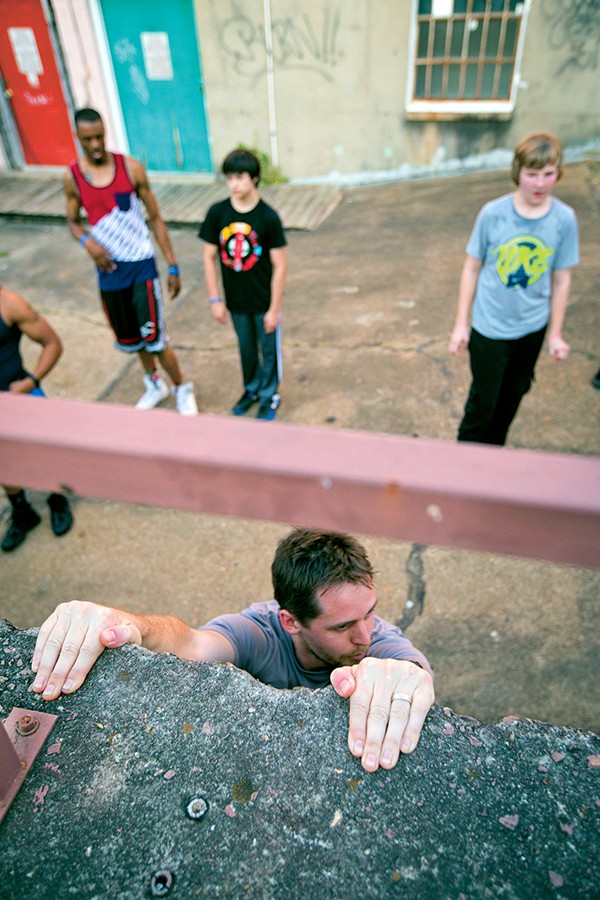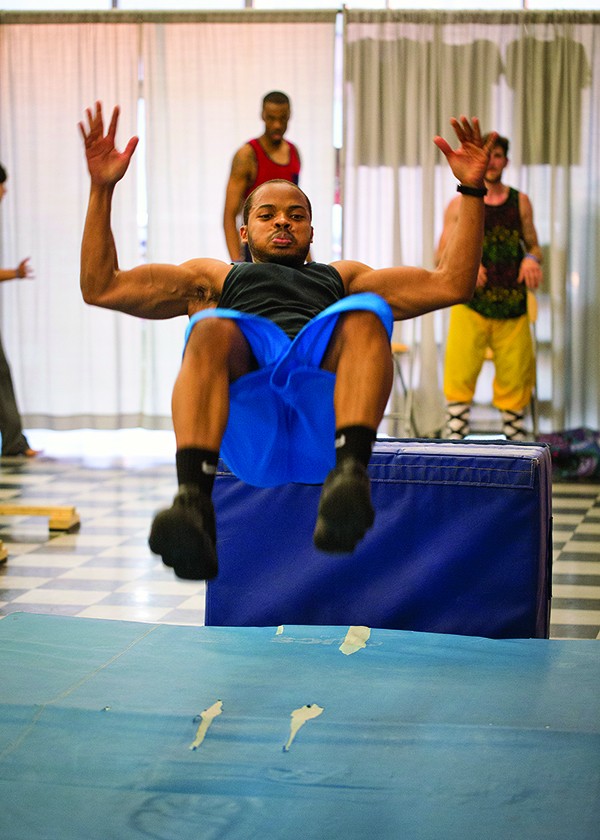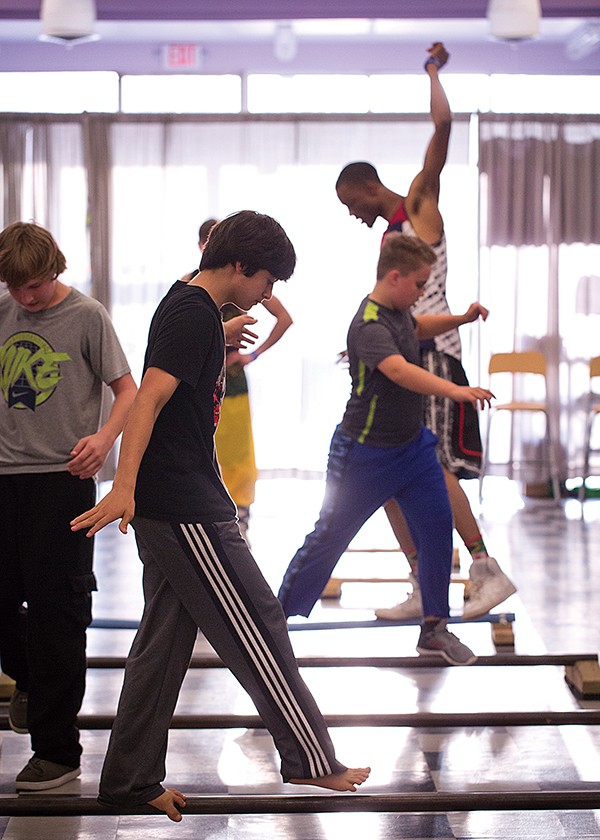A steady rain was falling from ominous, dark clouds over downtown last Friday, and the occasional thunderclap was so loud, the earth seemed to vibrate. But it was the first-annual We Jump the World Day, a worldwide celebration of parkour and freerunning, and the Memphis Parkour group wasn’t about to let a little bad weather ruin their good times.
A planned parkour meetup outside Bass Pro Shops was moved at the last minute to a dry spot in a covered enclave behind Alfred’s on Beale. It was there that I watched Kevin Hetzler run down a covered alley, scale a flight of stairs, use his hands to propel himself over a concrete wall, and then jump up to grab a stair railing that he proceeded to climb — all the while followed by his buddy Navii Heru filming the sequence with an iPhone camera on a selfie stick.
A few minutes later, 17-year-old Anna Holt, a life-long ballet dancer who told me she just started practicing parkour a couple months ago, hopped a stair railing, lifted herself up onto a wall, and then jumped off the wall into a front flip on the concrete below before landing gracefully on her feet. After the sequence was done, she grinned from ear to ear as her mother, who sat watching from a concrete bench, beamed with pride.
I stayed for more than a hour as Hetzler, Heru, Holt, and University of Memphis student Kenneth Shields took turn after turn demonstrating new ways to jump, swing, run, and vault over the architectural obstacles in their path. When I left to head back to the office, they were still going strong — rain be damned.

What Is It?
Parkour and freerunning — terms that may or may not be interchangeable depending on who you ask — are athletic disciplines that involve running, jumping, climbing, vaulting, swinging, rolling, flipping, or pretty much any movement used to get from one point to another.
Watching its practitioners (called traceurs) in action is akin to watching primates moving around in a jungle — hopping over brush, using their hands to propel them over logs, swinging from branches, doing whatever it takes to move over obstacles with grace and speed.
The parkour scene exploded in the U.K. back in the early-2000s, and it caught on in the U.S. soon after. But the parkour scene in Memphis didn’t emerge until a few years ago, mostly as a sort of underground pastime for athletic males in their late teens and mid-20s. But now, thanks to the efforts of a few Memphis parkour enthusiasts, the art is moving to the mainstream, attracting kids as young as 3 and adults of all ages to a series of classes hosted weekly at Co-Motion Studio in Crosstown. Co-Motion parkour coach/Memphis Parkour member Jonathan McCarver has seen such success that he’s planning to open a dedicated parkour gym near the airport this summer.
“I see a big boom for Memphis Parkour this year, at least by the end of the year. Memphis Parkour has been around about seven years, but it’s really just now breaking into the scene,” says Hetzler, a 27-year-old traceur who helps coach both the teen and all-ages classes at Co-Motion.

Hang on — classes at Co-Motion Studio include Parkour for Everyone, Sundays 1-2 p.m.; Low Impact Parkour, Sundays 2:15-3:15 p.m.; and Parkour Skills (13+), Tuesdays 6:30-7:30 p.m. Sign up at comotionmemphis.com.

The French Connection
Parkour’s roots trace back to 1902, when French naval officer Lieutenant Georges Hébert rescued more than 700 people from an erupting volcano on the Caribbean island of Martinique. Hébert was inspired by watching the survivors move — some successfully and some not so much — through obstacles in their path. The experience caused the well-traveled Frenchman to become interested in the physical development and movement skills of the indigenous people he’d seen in Africa and elsewhere.
He drew on those movements to create a military training discipline that using running, climbing, and man-made obstacle courses to recreate a natural environment. He dubbed the discipline “the natural method,” and it eventually became the basis for French military training. French soldiers in the jungles of Vietnam used the style to develop what they called parcours du combattant, meaning “the path of the warrior.”
In the early 1980s, former French special forces soldier Raymond Belle, who had trained under that style, passed it on to his son David, who was already training in gymnastics. David and his best friend Sébastien Foucan used those skills to create the modern discipline of parkour, which, in a nutshell, simply meant getting from point A to point B — over, under, and through obstacles in one’s path — in the most efficient way possible.
They called its practitioners traceurs and started a parkour group called the Yamakasi. The Yamakasi style was featured in a 2001 French film of the same name, and the movement exploded in Europe.
“It took a long time to make it to the States, but it flourished all over Europe,” McCarver says.
Foucan eventually split from the traditional parkour style by adding flips and wall spins — moves that may not be the most efficient way from one point to another but still look really cool. Remember the famous scene in 2006’s Casino Royale where James Bond chases the bad guy through a construction site — flipping, running, and eventually climbing and balancing on a beam hundreds of feet in the air? That bad guy was played by Foucan.

While it was originally developed as a military tactic, these days, parkour is more about fun than military prowess.
“Historically, you could say that parkour is more tied to functional capabilities, but that doesn’t matter anymore. Everyone is doing it to have fun,” McCarver says. “It encompasses all of the arts of movement that are just moving your body through your environment. It’s broad and it’s vague, and that’s what makes it interesting.”
There are no rules in parkour or freerunning, which sets it apart from traditional gymnastics, an art that utilizes specific equipment in a specific way. And although there are parkour competitions these days, it wasn’t really intended as a competitive sport.
“Competitions are less in the spirit of parkour. People tend to associate it with things like American Ninja Warrior, and it has strong crossover, but that’s not really parkour training,” McCarver says.
There’s a World Freerunning Parkour Federation (WFPF), and they certify coaches, but even that organization’s mission statement is intentionally vague in keeping with the spirit of the art.
From the WFPF mission statement: “We aren’t here to argue or try to regulate what Parkour/Freerunning is or is not, and we certainly don’t have any interest in actions that result negatively for the community. We encourage all individuals to find their own training, to discover new ways of seeing their environment, to be pathfinders for us all as they overcome whatever obstacles seem to be standing between them and where they dream of going.”

People all over town are flipping for parkour at Co-Motion Studio.
Ninja Acrobatics
When attempting to schedule an interview with Heru, I suggested we meet for coffee. His response: “Overton Park is nice. And not a big coffee drinker, sorry.” That’s when it dawned me — of course, you’re supposed meet up with a parkour guy in his natural environment.
We met up at noon in the picnic pavilion near the Rainbow Lake playground, and Heru, a tall and lanky 29-year-old who looks like he was built to flip, pointed out the various spots in the park where he’s sustained minor injuries practicing parkour.
“I sprained all 10 toes right there. I sprained my ankle over there,” Heru says with a chuckle, pointing in different directions.
Heru, who calls parkour “ninja acrobatics,” got his start about six years ago, inspired by a parkour video game called “Mirror’s Edge.” Now, he’s a parkour coach at Co-Motion Studio.
“I was watching the character move, and I was like, man, that stuff is totally doable. I started researching moves and watched a few tutorials, and then I just took off. I practiced by myself for about a year and a half, and then I Googled and found the Memphis Parkour Facebook page and Jonathan McCarver.
“He said he’d meet me one Sunday on the East Parkway side of Overton Park, so I met him there. And all these other guys showed up and started jumping in,” Heru says.
The Facebook page is primarily used to organize spontaneous meetups, sometimes thrown together an hour before meetup time. The traceurs often meet in Overton Park or spots around downtown or the University of Memphis.
“Surprisingly enough, we’ve never been kicked off the [Shelby County] Courthouse lawn. We use those big ole chunky concrete walls and the stairs,” McCarver says. “Beale Street Landing would be good, but they hate us. They made signs to discourage us from training there.”
Heru, who works at Subway by day and as a security guard at night, says parkour has not only given him “monkey strength,” it’s also helped him overcome depression.
“It’s a really good stress reliever. Parkour unwinds me, and it teaches me to overcome life’s obstacles, like being depressed. It’s like a Zen-meditation-type thing. It’s like a vacation inside yourself,” Heru says.
McCarver, 33, who works as a software developer at Lokion and does a little acting in local theater, discovered parkour after watching the action movie District B13 about 10 years ago.
“They used all of these skills, and I looked up parkour and found out what the discipline was. It was like, oh cool, there’s a name for what I’ve done my whole life. I’ve always been a movement person,” McCarver says.
Hetzler, who had previously studied kung fu and admits that he’s “always wanted to be a ninja,” began practicing about a year ago after learning about the Memphis Parkour group. For him, it all started with a magical night run.
“I finally got in touch with Jebediah [a member of Memphis Parkour], and he took me out for a run. I was brand new, fresh, green. We went outside and played on the vault box a little bit, and then he said, ‘Are you ready?’ before he took off running through his apartment complex.
“I just started following him, jumping over what little I could. We climbed through a hole in the roof of his apartment building, and that’s when I realized I couldn’t turn back. But I made my way up, and the sun was going down. I just smiled and thought, this is it. We ran for about five hours that night.”
It wasn’t long after that McCarver, Heru, and Hetzler began teaching classes together at Co-Motion.
“Parkour is about finding yourself and learning who you can be,” Hetzler says.
Of course, there’s a practical side, too.
“I’ve never had to run for my life, but I have been on my way somewhere in a hurry and used my parkour skills to get me there faster,” he says. “Someday, if someone is burning in a building, I want to be able to run in and save them. I’ve always had a superhero thing.”
And that points to, perhaps, the most important thing about parkour — it’s fun.
“We’re actually in the midst now of putting together some kind of gig where we dress as superheroes and entertain kids,” Hetzler says. “So now I can work on my superhero status.”

Parkour for Everyone
I sat in on a Tuesday night teen and adult parkour class at Co-Motion in early April. Teen boys whizzed past me — flipping, rolling, and vaulting over wooden boxes — as I scribbled notes. At one point, McCarver held a gold-and-purple hula-hoop a few feet off the floor as the five students — mostly teen boys and one 34-year-old man — took turns bounding off a wooden block, diving through the hoop, landing in a front flip onto a mat, jumping onto a wooden vault box, and then jumping down to a balance beam. A death metal jam by Paranoia blared over the speakers, adding to the high energy in the large cavernous space.
Hetzler was there as well, demonstrating McCarver’s instruction as the boys followed his lead. Hetzler effortlessly sprang from a wooden box on the black-and-white tile floor, glided through the hoop, and managed a front flip before landing smoothly on his feet.
“I love teaching the kids. They’re really my soft spot because they’re still innocent. They don’t understand the hardships of life,” Hetzler told me after class.
Co-Motion Studio in Crosstown is primarily a hula-hoop dance studio, offering classes in hooping, yoga, and, occasionally, belly dance or hip-hop dance. But on Tuesday nights and Sunday afternoons, it transforms into a parkour gym as McCarver uses mats, wooden vault boxes, old tires, and balance beams to create an obstacle course for students.
The Tuesday night class is for teens and adults, and the skills taught are more advanced. McCarver says it currently attracts mostly teen boys, but a few girls and older adults come from time to time.
He encouraged me to pop by one Sunday afternoon to watch the all-ages class, and it was a completely different scene. Although that class is advertised for all ages, the class has become more of a youth class, attracting lots of little kids and a few tweens. On the Sunday I dropped by in late April, there were about 15 kids ranging in age from 3 to 12. Parents stuck around to watch, and some even helped coach.
During the the warm-up, McCarver instructed the kids to crawl like zombies, using only their arms to propel themselves as they drug their legs on the floor behind them. Hetzler and Heru crawl around with the kids, too. And once the zombie kids made it around the room, a couple of parents gave it a try.
After the warm-up, McCarver, Hetzler, and Heru broke the kids into small groups to work on mastering the cartwheel. Some kids got it immediately, and others, try as they might, landed with plops on the mat over and over again.
One of the parents, Charles Mitchell, watched as his 4-year-old son, a cute blonde kid named Graham, bounded around the room. Mitchell says he enrolled Graham in parkour when he was 3.
“I read about parkour in a book called Natural Born Heroes, and I started researching it and watching videos. I thought my son would enjoy it,” says Mitchell, a local defense attorney. “I can tell it’s really benefitted him in his natural movements and his balance and spacial recognition. Whether he ends up playing traditional sports like soccer or baseball, what he learns here will translate to that.”
While the Sunday class caters to all ages, adults who aren’t parents might feel more comfortable in the Sunday low-impact class, which, while advertised to all ages, tends to attract students well into adulthood. I signed up for a low-impact class to see what it was all about.
The room was set up in a similar fashion to the advanced Tuesday night class, with mats, balance beams, and vault boxes arranged in an obstacle course of sorts, but McCarver assured me that I wouldn’t have to do anything I wasn’t comfortable with. As an injury-prone runner with a half-marathon on the horizon, I told him I’d rather not try flipping in the air.
McCarver led me (I was the only student that day) in an hour of instruction that involved using my arms to lift my body up and over high wooden vaults, doing shoulder rolls on a mat on the floor, and learning to balance on beams a few inches from the floor. Nothing dangerous or out of my comfort zone but certainly things I didn’t realize I was capable of. The next day, pain in my left shoulder was evidence that I’d worked muscle groups that don’t get much action in my day-to-day. I’ve clearly got a long way to go.
Susan Penn, 66, is a regular in the Sunday low-impact class, and she says it’s opened her up to new ways of moving her body. Penn, who also takes hula-hoop classes and yoga, is accustomed to physical activity, but she recently brought a friend who has some mobility issues to class, and McCarver customized the moves for her.
“It’s interesting how you can adapt physical activity to people with a variety of limitations in a way that’s fun and healthy. Old people tend to stop moving, and they shouldn’t,” Penn says. “After going to class a few times, I began to see more possibilities and ways to get around obstacles. Parkour is making me more playful. It’s making me try things that I suddenly feel like I might be able to do.”
For now, Co-Motion is the only place in town offering parkour classes, but McCarver is working on transforming a warehouse space at 2850 Lamb Place near the airport into a dedicated parkour gym. He doesn’t have an exact opening date in mind yet but says he’s aiming for some time after Memorial Day.
“At Co-Motion, we have space constraints, and we have to set up equipment and take it down for every class. We’ll be able to have things set up all the time, and we’ll have taller obstacles,” McCarver says.
He says he’ll keep some of the Co-Motion classes though, for those parents and students who would prefer the Midtown location. Once the gym is up and running, he hopes to expand parkour’s impact in Memphis even further.
“My mission is to show any person at any age and any skill level that, not only can they do parkour, but they can get healthy through fun and movement and play without repetitive, boring exercise,” he says. “I just want to get people moving.”